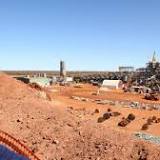China's Landspace conducts first VTVL test for reusable stainless steel rocket

HELSINKI — Chinese launch startup Landspace executed a first vertical takeoff, vertical landing with a test article Friday at a launch and recovery site at Jiuquan spaceport.
The Zhuque-3 VTVL-1 reusable vertical take-off and landing recovery verification rocket lifted off from Landspace facilities at Jiuquan Satellite Launch Center at 3:00 a.m. Eastern (0800 UTC), Jan. 19.
The methane-liquid oxygen test article reached an altitude of around 350 meters during its roughly 60-second flight before setting down in a designated landing area. The landing had an accuracy of about 2.4m and a landing speed of about 0.75m/second, according to Landspace.
The test is part of the development of the stainless steel Zhuque-3 rocket first announced in November 2023. The company is aiming for the first flight of Zhuque-3 in 2025. The company earlier planned to execute this first VTVL test last month.
The two-stage Zhuque-3 will be 4.5 meters in diameter and have a total length of 76.6 meters. Mass at liftoff will be about 660 tons and be powered by nine Tianque-12B engines. Payload capacity to LEO will be 21,000 kilograms when expendable. It will carry up to 18,300 kg when the first stage is recovered downrange, or 12,500 kg when returning to the launch site.
China’s reusable rocket race
The Zhuque-3 VTVL-1 test follows similar “hop” tests conducted by fellow Beijing-based launch startup iSpace in November and December last year. The Zhuque-3 VTVL-1 is powered by an engine model that will be used for orbital flight, as with iSpace’s tests.
The tests are somewhat analogous to SpaceX’s Grasshopper tests a decade ago as part of development of the Falcon 9. The recent hops also highlight the competition within the Chinese commercial launch sector to develop a reusable launch vehicle.
The Chinese government first opened up sections of the space sector to private capital in late 2014. These developments are seen to be a reaction to commercial developments in the U.S. The first launch vehicles developed were small, light-lift solid rockets. The first Chinese commercially-developed liquid propellant rockets launched last year.
Earlier Chinese hop tests by Jiangsu-based Deep Blue Aerospace—reaching the kilometer-level in 2022—and Linkspace used smaller engines. Another private launch startup, Galactic Energy, and state-owned spinoff CAS Space, have both held VTVL tests using jet-powered prototypes for their Pallas-1 and Kinetica-2 kerosene-liquid oxygen launchers. First launches are planned for 2024 and 2025 respectively. Both will initially be expendable
CAS Space has conducted VTVL tests with a small demonstrator. This uses jet engines rather than rocket engines and is for testing the GNC etc for ultimate goal of recovering rocket first stages. Looks like a small version of their answer to New Shepherd… https://t.co/nQ6fi5i2nE pic.twitter.com/YIMGxGOuiA
— Andrew Jones (@AJ_FI) April 4, 2023
Space Pioneer meanwhile aims to fly the Tianlong-3 rocket around June. That launcher will be comparable to the SpaceX Falcon 9, though it will also first be expendable.
Landspace meanwhile has plans to get back into orbit this year, following two successful Zhuque-2 methalox rocket launches last year. The company aims to launch three Zhuque-2 rockets in 2024, Landspace vice president Huang He told CGTN in December. It plans to double this cadence year on year, launching six times in 2025 and 12 in 2026.
Regarding Zhuque-3’s roadmap, Landspace CEO Zhang Changwu told Chinese media last month that the firm is working on a 200-ton full-flow staged-combustion-cycle engine, to be ready in 2028.
That engine would power a two-stage reusable launch vehicle with a diameter of 10 meters. The launcher appears to challenge the planned Long March 9 reusable rocket being developed by the China Aerospace Science and Technology Corp. (CASC), the country’s state-owned main space contractor.
A series of Chinese state-owned and commercial launch entities are currently developing reusable rockets.
| Company | Rocket Name | Rocket Type | Key Features or Notes |
| iSpace | Hyperbola-3 | Methane-liquid oxygen reusable | Payload capacity of 8,500 kg to Low Earth Orbit (LEO); first flight planned for 2025. |
| Landspace | Zhuque-3 | Methalox reusable | Payload capacity up to 21,000 kg to LEO; first flight planned for 2025. |
| Galactic Energy | Pallas-1 | Kerosene-liquid oxygen reusable | Payload capacity of 5,000 kg to LEO, or 3,000 kg to a 700 km sun-synchronous orbit (SSO). |
| CAS Space | Kinetica 2 | Kerolox reusable | Payload capacity of 7,800 kg to 500 km SSO. |
| Deep Blue Aerospace | Nebula-1 | Kerolox reusable | Payload capacity of 1,000 kg to 500 km SSO; first flight planned in late 2024. |
| Space Pioneer | Tianlong-3 | Kerolox | Comparable to Falcon 9 in launch capability; plans for a reusable first stage. |
| Orienspace | Gravity-2 | Kerolox | 25,600 kg to LEO. First flight in 2025; plans for a reusable first stage. |
| CASC | Various | Various | Working on reusable rockets including a new-generation human-rated launcher, spaceplane, and Long March 9 super heavy-lift launcher. |


 Australia
Australia Argentina
Argentina  Austria
Austria  Brazil
Brazil  Canada
Canada  Germany
Germany  Ireland
Ireland  Italy
Italy  Malaysia
Malaysia  Mexico
Mexico  New Zealand
New Zealand  Poland
Poland  South Africa
South Africa  United Kingdom
United Kingdom  United States
United States 



























